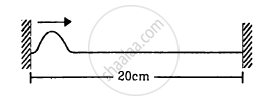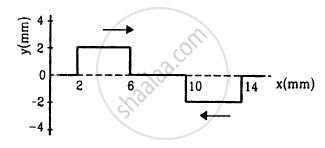Advertisements
Advertisements
प्रश्न
The equation of a wave travelling on a string stretched along the X-axis is given by
\[y = A e {}^- \left( \frac{x}{a} + \frac{t}{T} \right)^2 .\]
(a) Write the dimensions of A, a and T. (b) Find the wave speed. (c) In which direction is the wave travelling? (d) Where is the maximum of the pulse located at t = T? At t = 2 T?
उत्तर
Given,
Equation of the wave travelling on a string stretched along the X-axis:
\[y = Ae {}^\left( \frac{x}{a} + \frac{t}{T} \right) {{}^-}^2 \]
(a) The dimensions of A (amplitude), T (time period) and \[a = \frac{\lambda}{2\pi}\] , which will have the dimensions of the wavelength, are as follows:
\[\left[ A \right] = \left[ M^0 L^1 T^0 \right]\]
\[\left[ T \right] = \left[ M^0 L^0 T^{- 1} \right]\]
\[\left[ a \right] = \left[ M^0 L^1 T^0 \right]\]
(b) Wave speed, \[\nu = \frac{\lambda}{T} = \frac{a}{T} \left[ \lambda = a \right]\]
(c) If \[y = f \left( t + \frac{x}{\nu} \right)\] , then the wave travels in the negative direction; and if \[y = f \left( t - \frac{x}{\nu} \right)\] ,then the wave travels in the positive direction.
Thus, we have:
`"y"="Ae"^[[(x/a)+(t/T)]^(-2)]`
\[ = A e^{- \frac{1}{T} \left[ t + \left( \frac{xT}{a} \right) \right]^2} \]
\[ = A e^{- \frac{1}{T}\left[ t + \frac{x}{V} \right]} \]
\[ = A e^{- f\left[ t + \frac{x}{V} \right]}\]
Hence, the wave is travelling is the negative direction.
(d) Wave speed, \[v = \frac{a}{t}\] Maximum pulse at t = T = \[\left( \frac{a}{T} \right) \times T = a\] (Along the negative x - axis)
Maximum pulse at t = 2T = \[\left( \frac{a}{T} \times 2T \right) = 2a \] (Along the negative x - axis)
Therefore, the wave is travelling in the negative x-direction.
APPEARS IN
संबंधित प्रश्न
A wire stretched between two rigid supports vibrates in its fundamental mode with a frequency of 45 Hz. The mass of the wire is 3.5 × 10–2 kg and its linear mass density is 4.0 × 10–2 kg m–1. What is (a) the speed of a transverse wave on the string, and (b) the tension in the string?
A train, standing in a station-yard, blows a whistle of frequency 400 Hz in still air. The wind starts blowing in the direction from the yard to the station with at a speed of 10 m s–1. What are the frequency, wavelength, and speed of sound for an observer standing on the station’s platform? Is the situation exactly identical to the case when the air is still and the observer runs towards the yard at a speed of 10 m s–1? The speed of sound in still air can be taken as 340 m s–1.
A SONAR system fixed in a submarine operates at a frequency 40.0 kHz. An enemy submarine moves towards the SONAR with a speed of 360 km h–1. What is the frequency of sound reflected by the submarine? Take the speed of sound in water to be 1450 m s–1.
The radio and TV programmes, telecast at the studio, reach our antenna by wave motion. Is it a mechanical wave or nonmechanical?
Velocity of sound in air is 332 m s−1. Its velocity in vacuum will be
A wave pulse, travelling on a two-piece string, gets partially reflected and partially transmitted at the junction. The reflected wave is inverted in shape as compared to the incident one. If the incident wave has wavelength λ and the transmitted wave λ'
A sonometer wire supports a 4 kg load and vibrates in fundamental mode with a tuning fork of frequency 416. Hz. The length of the wire between the bridges is now doubled. In order to maintain fundamental mode, the load should be changed to
A string of length 20 cm and linear mass density 0⋅40 g cm−1 is fixed at both ends and is kept under a tension of 16 N. A wave pulse is produced at t = 0 near an ends as shown in the figure, which travels towards the other end. (a) When will the string have the shape shown in the figure again? (b) Sketch the shape of the string at a time half of that found in part (a).

A 200 Hz wave with amplitude 1 mm travels on a long string of linear mass density 6 g m−1 kept under a tension of 60 N. (a) Find the average power transmitted across a given point on the string. (b) Find the total energy associated with the wave in a 2⋅0 m long portion of the string.
Two waves, travelling in the same direction through the same region, have equal frequencies, wavelengths and amplitudes. If the amplitude of each wave is 4 mm and the phase difference between the waves is 90°, what is the resultant amplitude?
Following figure shows two wave pulses at t = 0 travelling on a string in opposite directions with the same wave speed 50 cm s−1. Sketch the shape of the string at t = 4 ms, 6 ms, 8 ms, and 12 ms.

A steel wire fixed at both ends has a fundamental frequency of 200 Hz. A person can hear sound of maximum frequency 14 kHz. What is the highest harmonic that can be played on this string which is audible to the person?
A man standing unsymmetrical position between two mountains and fires a gun. He hears the first echo after 1.5 s and the second echo after 2.5 s. If the speed of sound in air is 340 m/s, then the distance between the mountains will be ______
An organ pipe of length 0.4 m is open at both ends. The speed of sound in the air is 340 m/s. The fundamental frequency is ______
For the travelling harmonic wave
y (x, t) = 2.0 cos 2π (10t – 0.0080x + 0.35)
Where x and y are in cm and t in s. Calculate the phase difference between oscillatory motion of two points separated by a distance of `λ/2`.
Speed of sound wave in air ______.
A steel wire has a length of 12 m and a mass of 2.10 kg. What will be the speed of a transverse wave on this wire when a tension of 2.06 × 104N is applied?
If c is r.m.s. speed of molecules in a gas and v is the speed of sound waves in the gas, show that c/v is constant and independent of temperature for all diatomic gases.
An engine is approaching a cliff at a constant speed. When it is at a distance of 0.9 km from cliff it sounds a whistle. The echo of the sound is heard by the driver after 5 seconds. Velocity of sound in air is equal to 330 ms-1. The speed of the engine is ______ km/h.
Two perfectly identical wires kept under tension are in unison. When the tension in the wire is increased by 1% then on sounding them together 3 beats are heard in 2 seconds. What is the frequency of each wire?
